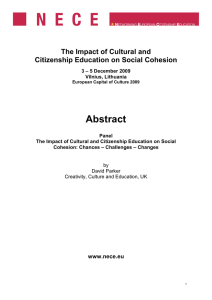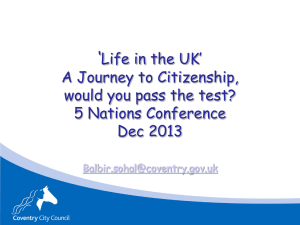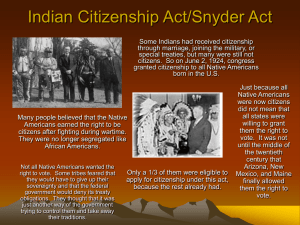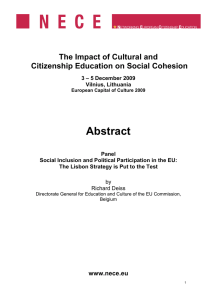Report The Impact of Cultural and Citizenship Education on Social Cohesion
advertisement
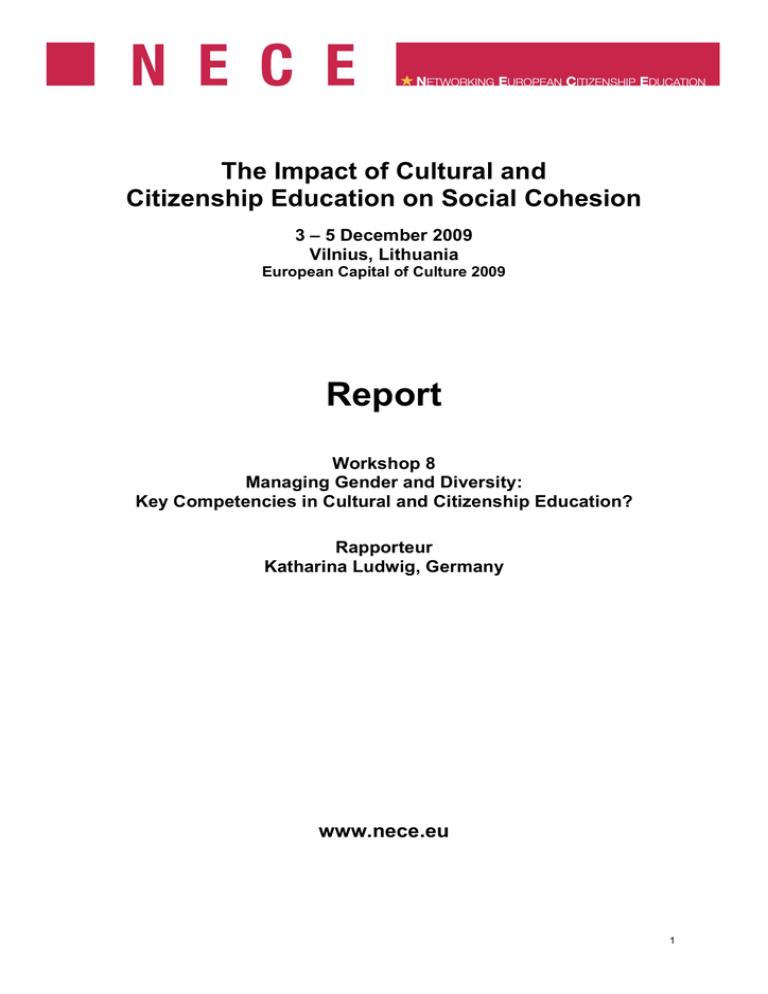
The Impact of Cultural and Citizenship Education on Social Cohesion 3 – 5 December 2009 Vilnius, Lithuania European Capital of Culture 2009 Report Workshop 8 Managing Gender and Diversity: Key Competencies in Cultural and Citizenship Education? Rapporteur Katharina Ludwig, Germany www.nece.eu 1 Conflicts of Cohesion Managing Gender and Diversity: Key Competencies for Cultural and Citizenship Education? Scientific Inputs: Krassimira Daskalova, University St. Kliment Ohridski (Bulgaria) Anne Sliwka, Teacher Training College Heidelberg (Germany) Project Presentations: Randi Husemoen & Diana Alnæs, Vox – The Norwegian Institute for Adult Learning (Norway): Tools For Diversity Petra van Loon, MOVISIE (The Netherlands): One Thousand and One Empowered Moderation: Mieke Verloo, Radboud University Nijmegen (The Netherlands) For promoting social cohesion, a better understanding of social conflicts seems crucial. The workshop on Gender and Diversity Management, held at the NECE conference on social cohesion in Vilnius, Lithuania, scrutinized the impact of cultural and citizenship education efforts. Researchers and practitioners from all over Europe discussed how educational institutions shape our understanding of community, trust and social value; and how efforts to reform these institutional patterns are highly influenced by individuals following their own agenda. As political scientist Mieke Verloo stated in her opening remark, there is no point of neutrality, even when talking about social cohesion there is no such thing as a smooth story of success. “Maybe we will learn most if we share our doubts.” Di v ersit y Dealing with social complexity also means to face individual complexity: ‘Diversity’ therefore was based on the notion of hybrid identities in a pluralist society where not two individuals share exactly the same preference system. Dimensions of diversity include gender, age, ethnicity, religious and sexual orientation, physical difference (e.g. disability), lifestyle. When referring to individuals or groups and ascribing them one or more of these attributes, one should not forget that none of these features is naturally given and fixed; they are all socially constructed and reconstructed. They are situational and they can change. Also one’s possibility to act non-identitarily should be kept in mind. Educationalist Anne Sliwka emphasized a developmental approach as in saying “I am many things and I can be very many more things.” Workshop participants agreed, though, that not all of these diversity dimensions have the same impact on one’s position and chances in the social sphere. Hierarchies among certain attributes might vary in different social settings – in one situation they may be most influenced by being identified as man or woman, in another by being ascribed to a certain ethnicity or age group. But in any given social context some attributes entail deeper inequalities than others. S o cial c o h esi o n Recently, many projects of cultural and citizenship education have rather fostered individual than structural approaches in order to achieve social cohesion. The concept of social capital as proposed by U.S. political scientist Robert Putnam is most influential here. Putnam analyzed social capital as a collective resource which strengthens norms of reciprocity, networks and flows of information and builds trust among individuals. Within this concept ‘bonding’ refers to specific trustful relationships among people who share many significant attributes, ‘bridging’ means generalized trust beyond one´s own features. Keeping gender and other discriminatory relations in mind, workshop participants objected that social cohesion could not be tackled from a ‘bottom up’ perspective alone. Structural inequalities – within institutions, along the hierarchies and by the means of law – cannot be ignored. 2 Sc h o o ls The workshop’s scientific inputs both focussed on school as a prime site of learning social cohesion – or the contrary. Historian Krassimira Daskalova showed that efforts to reform Central Eastern and South Eastern European text books after 1989 in order to free them from the ideological bias of “old regimes” failed in providing new tools for understanding conflicting interests and a diversity of social actors. Having analyzed the visual representation of women and gender and gender sensitive language she comes to the following conclusion: Women are portrayed as naturally passive beings bound to their gender-based, reproductive function as opposed to the universal characteristics of the way in which men act. Relevant history is reduced to the male-dominated public sphere, whereas the history of everyday life remains ‘private’ and untold. Ms. Daskalova calls this “the silence of the modern ages”. Ms. Sliwka followed with her vision of schools as core social centres and learning organisations. Through ‘service learning’ students gain bridging experience among their own school populations or in exchange with other communities; e.g. students teach elderly people how to use their mobile phones. Service learning does not correspond to charitable work in a classical sense. Participants do something good, but they do it also for their own benefit. Empirical results show that involved teenagers showed more transcendence and felt less stuck with their own problems. Identification with schools increased and vandalism declined. In the course of discussing these two very different accounts of school and social cohesion it evolved that teachers – as individuals implementing education programmes and social intermediaries – gained more and more attention. Soon it was clear that projects rise and fall with teachers’ motivation, political attitudes and their good will to intervene in social settings. T o ol s The following two project presentations further suggested that the organisational life, the non-neutral setting of cultural and citizenship education is sometimes insufficiently taken into account. Both projects aimed at Gender and Diversity competences but – at least at first sight – with different target groups. “Tools for Diversity” is a lifelong learning project among five adult learning organizations in Finland, Poland, Greece, Spain and Norway, funded by the European Union. As education advisers Randi Husemoen and Diana Alnæs explained, it serves for developing self-assessment tools to identify gaps in individual and organizational competencies. A questionnaire, core curriculum and training course were developed that allow participants to map their awareness of diversity issues from two sides. E.g. they had to react to myths of disability, but also to myths of 100% performance. The project particularly aimed at attitudes and skills, i. e. everyday competences. One Thousand and One Empowered, a Dutch project consulted by Petra van Loon, also employed common knowledge. Migrant women are enhanced in volunteering to experience their capacities while municipalities align their existing offers and make them more easily accessible. M ai n r es ul ts 1 ) T AR G E T G R O U P S AR E N O T T H E U S U AL SU S P EC T S . Throughout both inputs and project presentations workshop participants maintained the idea of ‘target groups’ for cultural and citizenship education, if talking from a Gender/Diversity perspective. However, it turned out that primarily target groups might not be those at the fringes of society, as usually ‘suspected’, but rather those individuals right in the centre that have the power to shape structures and have access to intermediary positions of implementation. As Ms. Sliwka gave the impression that convincing the teacher is key in social learning projects for students, Ms. van Loon highlighted the importance of informing municipalities about on-site realities and get them involved while talking about an endeavour to make migrant women volunteer. 3 2 ) C O N F L IC T S O F C O H E S I O N . If social cohesion is understood as a social capital and as leading to social equality, projects have to develop combined approaches which help individuals to bridge differences but at the same time inform them about the bigger picture, their rights and their way to get involved in decision-making processes. Political reflection, civic education and empowerment therefore have to accompany initiatives for social cohesion. The concept of social capital should not replace a critical citizenship, the small social experiment should be seen as a starting point for political action. Governmental fondness for the individual solving of social problems and unrest should be questioned. It could cover up shifts in state activities, like cuts in social welfare. Increasing volunteering might not be a sufficient substitute but a result of expanding informal economies like collecting assets for future employability. Overcapacities for less controversial social engagement, like food collections, and under-capacities for more controversial topics such as refugee assistance might be a result. Hence it is important to understand the diverse, maybe conflicting interests of parties and players involved in cultural and citizenship education. In the same project for social cohesion the participants, officers, consultants and politicians can have a very different agenda. Sociology and politics of organizations might explain why sometimes municipalities set up programmes but explicitly do not want their beneficiaries to go further, as it was mentioned by a practitioner. The notions of social capital, volunteering and knowledge are highly socially structured. They risk continuously highlighting certain activities in certain places by certain people and neglecting others. E.g. there is still a gender bias in public/private activities, a cultural bias in the definition of social capital, and the list goes on. Cultural and citizenship educators need to better reflect on their own social position and their agenda. 3) N O M O R E PR O J E C T S . “ Don’t add more new projects,” was one of Ms. van Loon’s main messages when looking at the life-cycles of social initiatives: “Assess and align what is already there and offer an easy gateway to participation.” Support for cultural and citizenship education is often subordinated to the rules of market, elections and public relations. Every new head in office has to contribute new projects on every term, and so often already existing ones are terminated for budget reasons. Pilot projects are widely communicated but rarely implemented as a common practice. Workshop participants reported that this is true for the municipal, the national as well as the European level. To sum up, sometimes it seems as if cultural and citizenship education itself needs better bonding among its own kind and bridging to those it is meant for. 4
